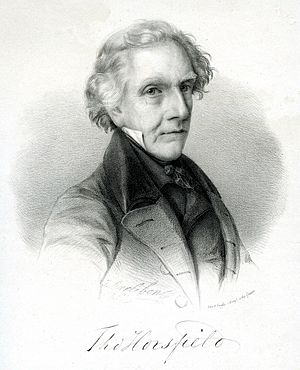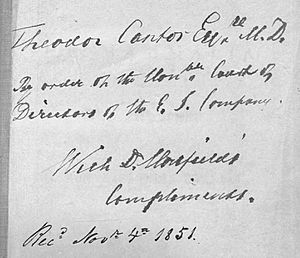Thomas Horsfield facts for kids
Thomas Horsfield (born May 12, 1773 – died July 24, 1859) was an American doctor and scientist who studied nature. He spent a lot of time working in Indonesia, where he found and described many new kinds of plants and animals. Later, he became a curator (someone who takes care of museum collections) at the East India Company Museum in London.
Contents
Early Life and Learning
Thomas Horsfield was born in Bethlehem, Pennsylvania. His family were Moravians, a Christian group who believed that learning was very important. He went to Moravian schools and later studied medicine at the University of Pennsylvania. He finished his studies in 1798. For his final project, he wrote about how poison ivy affects the body. This showed his early interest in plants, also known as botany.
Adventures in Asia
In 1799, Thomas Horsfield became a doctor on a ship called the China. This ship was sailing to Java, a large island in Indonesia. When he arrived, he was amazed by the beautiful nature there.
In 1801, he started working as a doctor for the Dutch army in Batavia (now Jakarta). He became very interested in the plants, animals, and rocks of the area. He especially loved studying plants and insects. One of the first animals named after him was a butterfly called Taenaris horsfieldii.
In 1811, the British East India Company took control of Java from the Dutch. Thomas Horsfield then began collecting natural history samples for the governor, Sir Thomas Stamford Raffles, who was also his friend. In 1816, Java was given back to the Dutch. Horsfield then moved to another Indonesian island called Sumatra. By 1819, he had to leave the island because he was not well. He sailed back to London on a ship called the Lady Raffles.
Life in England
After returning to London, Thomas Horsfield stayed in touch with Sir Stamford Raffles. He became a keeper, and later a curator, at the East India Company Museum on Leadenhall Street in London. He worked there until he passed away on July 24, 1859.
Horsfield was interested in many areas of science, including geology (the study of rocks and Earth), botany (plants), zoology (animals), and entomology (insects). He became a member of important scientific groups like the Royal Society of London and the Linnean Society. He also helped start the Zoological Society of London in 1826 and the Royal Entomological Society of London in 1833. He was buried in a Moravian cemetery in Chelsea.
His Published Works
Thomas Horsfield wrote several important books about his discoveries. One of his famous works was Zoological Researches in Java and the Neighbouring Islands, published in 1824.
He also worked with other scientists. With Nicholas Aylward Vigors, he helped classify many birds, especially Australian ones. He also worked with botanists Robert Brown and John Joseph Bennett on a book about rare Javanese plants called Plantae Javanicae rariores.
Animals and Plants Named After Him
Many animals and plants have been named in honor of Thomas Horsfield because of his important work. Some of these include:
- Javanese flying squirrel, Iomys horsfieldii
- Horsfield's fruit bat, Cynopterus horsfieldi
- Horsfield's shrew, Crocidura horsfieldi
- Horsfield's bat, Myotis horsfieldii, a type of small bat
- Horsfield's flying gecko, Ptychozoon horsfieldi, a lizard that can glide
- Russian tortoise, Testudo horsfieldii
- Horsfield's spiny lizard, Salea horsfieldii, a lizard found in India
- Malabar whistling thrush, Myophonus horsfieldii, a bird from India
- Indian scimitar-babbler, Pomatorhinus horsfieldii, another bird from India
- White's thrush (Horsfield's thrush), Zoothera horsfieldi, a bird from Indonesia
- Oriental cuckoo, Cuculus horsfieldi
- Horsfield's bronze cuckoo, Chrysococcyx basalis
- Common darkie, Paragerydus horsfieldii, a small butterfly from India
- Arhopala horsfieldi, a butterfly found in Asia
- South Indian blue oakleaf, Kallima horsfieldii, a butterfly from India
- Horsfieldia, a plant group found in Southeast Asia
- Horsfield's Tarsier, Cephalopachus bancanus
See also
- Category:Taxa named by Thomas Horsfield



